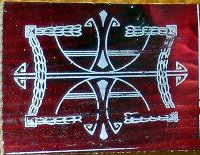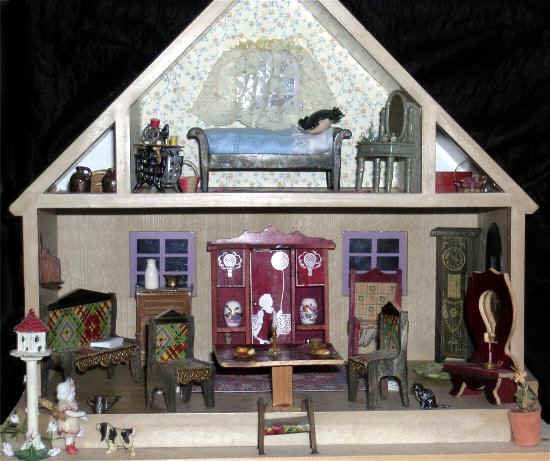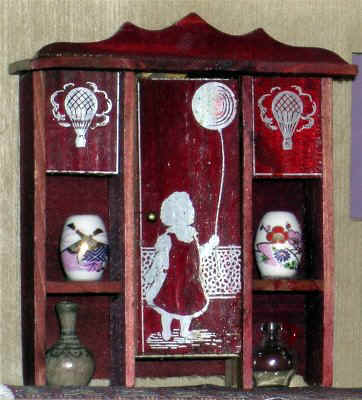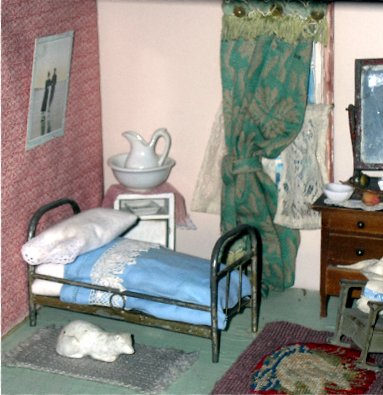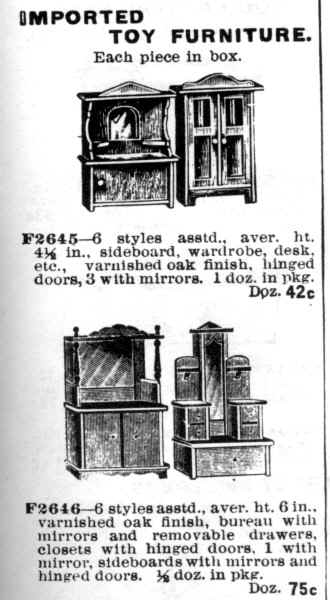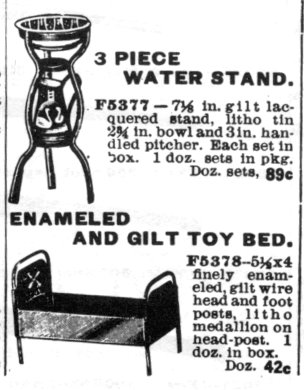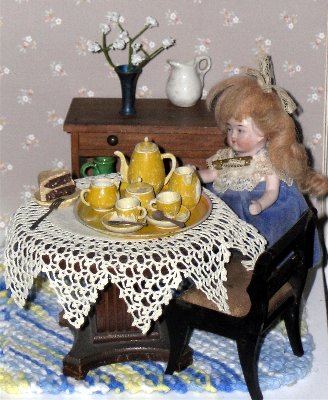1890s 1910 to 1920 part 1: 1920s part 2: late 1920s part 1: 1930s part 2: 1930s 1940s 1950s part 1: 1960-1990 part 2: 1960-1990 select references on dollhouses home page There was, of course, no dramatic break in the year 1900 in dollhouse production but there was an ever increasing trend towards mass production and distribution with Germany the major player until the disruption of the First World War. Mail-order catalogues serving the middle class became more prevalent with toys one type of product they carried. In the last two decades of the 19th century, the number of illustrations increased in such catalogues with a noticeable improvement and quantity in the 20th century. This is a boon for collectors who can study original or facsimile catalogues to identify and date items in their collection. Collecting. With
the passage of time, miniatures from this period are now considered highly desirable and
"antique." Even items made in large quantities may become scarce depending upon
how many were discarded in the past and how many are now disappearing into collections.
With the arrival of web auction houses such as eBay, a new system of supply and demand has
supplemented traditional antique and second-hand shops and auctions. Now the collector is
not bound by her or his geographical location either at home or on travels, as long as one
is prepared to accept the travails of money exchange, possible customs intervention, and
shipping costs. One of the disadvantages is having to judge the condition and authenticity
of the item from photographs and written descriptions in contrast to being able to hold
and closely examine it at a shop. There are many, many instances where the knowledge of
the web seller is limited (in fairness, miniature and dollhouses may not be the
Returning the the opening decade of the 20th century, much about this dollhouse (below) found in south-eastern Ontario, Canada, suggests the previous century, but the date of 1906 is still distinguishable near the applied swan, as well as "Marie's Villa" (her last name is difficult to read). Also, a 20th century indication is the material, plywood, which was only beginning to make inroads into the lumber business in the first decade of the century. The principle of 2 or 3 thin pieces of wood glued in with the grain running at 90 degrees from each other to gain strength was known long before, but widespread commercial application was delayed until about 1930. The house was made to be entirely collapsible with notched corners to hold it together. This suggests a commercial interest in shipping it flat in a box but its idiosyncratic form and decoration are compatible with an individually made product. The maker was obviously highly skilled with a jig saw. The scrolls, culminating in fleur-de-lys over the upper windows, look back to Rococo Revival not to the incoming, anti-historical modern styles. This was also true of the traditional lattice-work filling the windows in a manner reminiscent of lead window tracery of medieval revival style, popular from the mid 19th century. There can be little doubt all this "gingerbread" fantasy appealed greatly to Marie's heart and eye.
all photos J. McKendry©
Of a more
prosaic nature, the home-made dollhouse (left) from the K
A more highly decorated version is in Bicknell's architectural pattern book of 1878 (above right).
Below is an L-shape dollhouse with a great porch recorded on a stereograph of 1905.
Home-made houses were consistently made throughout the time period (1890 to 1990) under study and present difficulties in dating unless some style or building technique help - best of all, if the maker signed and dated the piece!
FURNISHINGS Toy cook
stoves for wood or coal appeared consistently throughout the first four decades of the
20th century, despite the inroads of gas and then electricity. Imported tin stoves were
advertised in Butler Brothers (right) in 1895 but continued to at
least the First World War. The smallest in this advertisement has a five-inch back and
could
Hooks on the back plate accommodated kitchen gadgets such as graters, cookie sheets, moulds and dust pans. Covered stew pots were permanently fixed to the stove top. The origins of these tin stoves, with a tile pattern represented on the oven box, is likely Germany. North American families, in real life, favoured cast-iron for woodstoves. There are charming lion paws acting as the feet of the stove (below left), which is 6½ inches high.
(For more on tin stoves, please see section 4 of the Gallery of Images - link at the bottom of this page)
all photos J. McKendry©
In this
period, stoves, used for heating with coal or wood, were often vertical (thus saving
on floor space), highly ornamented and topped by some kind of finial. The example (left) is 3½ inches high, in painted pewter, moulded with delicate floral
patterns. The ad is from Stirn's catalogue of 1893, Manhatten.
In the late 19th century in real life, there was an enthusiasm for Japanese paintings, porcelain and furniture among the "in crowd." Here this is filtered down here into the mainstream as a miniature bamboo set advertised in the Montgomery Ward catalogue of 1903. This fascination for the exotic had affected the art of avant-garde French and Dutch artists Gauguin and Van Gogh in the 1880s.
all photos J. McKendry©
French "penny toys" were popular at this time, and many recall the Rococo Revival style from the last century. The delicate scrolls and curves seem to suit these diminutive pieces made in painted pewter, some in France by Simon and Rivollet, 1890s to 1920s, and others in Germany. The filigree piano top (below) features, oddly enough, a cock or rooster, still being advertised as late as 1929 in the American G. Sommers catalogue. There are many scales - the tiniest shown here (below right) are ladderback side-chairs (1 inch high) with woven seats and a pedestal table, the top of which is moulded like a gameboard and is 1¼ inches in diameter. The gold settee in the top left picture is 1½ inches high, while the silver one is 2 inches (bottom right picture). The copper sewing machine, 1½ inches high, is marked DEPOSE ["registered"] FRANCE. (Metal filigree fireplaces are discussed in the next section, 1910 to 1920.)
all photos J. McKendry©
1890s 1920s part 1: 1930s part 2: 1930s 1940s 1950s part 1: 1960-1990 part 2: 1960-1990
|
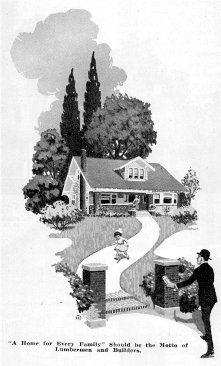 The survival rate for factory-made dollhouses from this
period is greater than the previous decades and, today, the value of these items as
antique is significant This is particularly true for American-made examples which became,
at this time, a serious competitor with Germany for the North American toy market. From
1914 to 1918, distribution of goods in Europe was disrupted by the First World War. The survival rate for factory-made dollhouses from this
period is greater than the previous decades and, today, the value of these items as
antique is significant This is particularly true for American-made examples which became,
at this time, a serious competitor with Germany for the North American toy market. From
1914 to 1918, distribution of goods in Europe was disrupted by the First World War. Although in use from the late 19th century, coloured paper glued over wood or heavy cardboard was, in this decade, a very important and prevalent material for dollhouses and certain examples of miniature furnishings. It involves some visual acceptance by the user that what is represented as three-dimensional on a flat or two-dimensional surface is the equivalent to actual three-dimensions. Factory techniques incorporated speed and minimized skilled hand-work while favouring machine-printed paper on cheap thin boards, although actual miniature wood turnings, balconies, dormers, bay windows and steps may also be incorporated. These added to the final cost of the houses. One of the appealing factors for today's collectors is that the fussy, highly ornamented architecture of the period looks well when reduced and printed in colour. With an ever-growing theme of love of family and home-life, the dollhouse suited this prescription. Many inexpensive bungalows were made, just as was happening in real life and the middle class grew and demanded single-family housing. "A Home for Every Family" was the wish of this illustration (left) from the American Builder of November 1917. Returning home after work, father, dressed in suit and hat and clutching the evening newspaper, greets his young daughter, while his wife waits on the verandah of their bungalow.
The same magazine carried other designs for bungalows with
strongly detailed verandahs, hipped (left)
all photos J. McKendry©
While the one- or two-storey dollhouses showed interesting printed exteriors, some of the interiors can be disappointing, as there may be no cut-out windows, actual stairs or doors. The rooms are often shallow and can only accommodate furniture in a small scale. Pressed cardboard furniture by a German firm, Gottschalk, was a popular choice. The wallpapers, however, add visual interest.
1914
This small (14¾ inches high, right) house, likely made in the USA, was advertised in the Butler Brothers' catalogue of 1914 (above, see second house from the right and right) for 95 cents each. The decoration is printed directly on the wood in a manner associated with the Converse Company of Massachusetts. The colours vary. The turned posts at the top of the steps are interesting, as is the incorporation of a railed balcony to the left of the dormer. The roof, dormer and bay window are solid and do not create space on the interior. The front wall with the verandah swings out to reveal a single room decorated with a rug, four windows with blinds, a picture and fleur-de-lis wall paper. The "stone" foundation is 12 inches deep by 14 inches wide.
This two-storey, blue-roof house, with its exterior walls covered by printed paper, was likely made in Germany about 1900 and still has its original Moritz Gottschalk furniture. Housed in a large toy-making factory in Germany, the Gottschalk company made dollhouses, rooms, furniture and shops from about 1873 to the Second World War, when toy production was interrupted. It began again in 1947. Sidechair shown in the 1912 Gottschalk catalogue (and
still shown in 1927)
all photos J. McKendry©
Rooms and furniture from the 1909 Gottschalk catalogue; the furniture is finished with gold detailing on dark red or cream; open fretwork forms cresting on cupboards, desks and beds
The most sought after American dollhouse manufacturer from this period is Bliss, sometimes identifiable by a mark such as B in a heart. The Rhode Island company made lithographed dollhouses from 1889 to 1914 and then the company was taken over by Mason & Parker who made houses into the 1920s. Below are items from the 1911 Bliss catalogue.
Window from a building of 1910 in Kingston, Ontario, Canada. Its allegiance to classicism is also found in the Bliss "elegant suburban home for good little people." (left)
all photos J. McKendry© The stable, c1900, on the right has a false upper front covered with paper hiding a lean-to roof. A small door opens into a hay loft (or room for farm workers given the existence of windows) and there is a metal crib for hay, as well as stalls, in the open lower area. It is similar to model 5544 by the Moritz Gottschalk toy factory of Germany. It is likely that the American Bliss stables (see 1911 catalogue image above) were influenced by German models, because half-timber construction in farm buildings is a European -- not North American -- tradition. all photos J. McKendry©
NOTE: BE SURE TO CHECK OUT "THE GALLERY OF IMAGES" (LINK AT BOTTOM OF THIS PAGE) FOR MORE ON VARIOUS STABLES, AS WELL AS SELECTED CATALOGUE ILLUSTRATIONS SHOWING BLISS HOUSES & STABLES
This wonderful Bliss house (left) of 1901shows the then fashionable Moorish "keyhole" arch -- part of the search by architects for variety and an interest in the exotic (below) . It appears on a brick and stone house of 1886 in Kingston, Ontario (right). Notice the same format of a pronounced pediment crowning the front facade, as well as the love of texture.
FURNISHINGS
Again the
style of certain dollhouse furnishings was old fashioned, compared to what was being
bought as new furniture by a child's family. On the other hand, real houses were furnished
by a mix of ages and styles. Complicating the story is the long span of years a company
may have produced miniature items
all photos J. McKendry©
In contrast, Mission oak furniture was plainer and heavier, supposedly modeled after furniture found in early Franciscan mission stations in California but also related to the British Arts & Crafts movement, which emphasized functionality and craftsmanship. High style is here reduced to factory-made furnishings for the masses in the 1908 Sears Roebuck catalogue (showing real furniture, below left).
This dollhouse table (above right) has the severe lines associated with the Mission style, as well as the typical pierced openings in the apron. The painted stylized decoration on top shows the influence of Art Nouveau. The advertisement of 1912 from Sears Roebuck (right) for dollhouse parlour and bedroom sets in "a very fancy" Mission style is a contradiction - a misunderstanding of the nature of the style.
Likely of German or British origins, this
bedroom set (below, wardrobe, washstand, bedside cupboard and bed)
is painted off-white with Art Nouveau (a style of the 1880s to 1914 incorporating
strongly stylized natural forms - s
all photos J. McKendry©
above main floor Sets of furniture, likely made in Germany in the early 20th century, from stained thin wood and printed cardboard with cloth and metal fringes. The case pieces are influenced by Art Nouveau, as is the matching table top illustrated above. The red wardrobe is especially charming with a little girl holding a balloon while, to each side, hot air balloons are floating. The scale is smaller than the usual 1:12: the wardrobe is 4¼ inches high.
(The sewing machine is likely French, painted metal, c1900; the bed is iron, American, attributed to Stevens & Brown, late 19th century; the dressing table is by Kilgore, iron, American, c1930; and the bird house is English, metal c1940.)
Iron and brass beds were very popular at this time, and often incorporated scrolls. The material and forms translated well into miniature versions such as this one with a decorative circle on the side railings. The bed in the advertisement (below left) of 1914 from Butler Brothers catalogue is painted enamel over sheet metal with wire rails.
From the same 1914 catalogue is "imported toy furniture" (below right) in varnished oak. The average height of the sideboards, wardrobe, desks, etc. in the upper row is 4½ inches.
all photos J. McKendry©
Somewhat larger than the usual scale (1:12) for dollhouses, these tea sets (left) are still remarkable for their delicacy, given that they are turned in wood. This one is painted a strong mustard colour and sits on a matching tin round tray, stamped "Germany." The era of such sets likely spans a wide range from the 1890s to pre World War Two. The piece of cake and set of cutlery came from the same American dollhouse. The teaspoons are just under one inch long. The doll, table and chair are likely German. The collector can assemble these larger items together to form visually successful room settings.
(note: see also Gallery of Images, section 1 for more pictures of early furnishings, section 2 for early dollhouses, section 4 for kitchens & dining rooms & section 5 for parlours - link at bottom of this page)
1890s 1900 to 1910 1910 to 1920 part 2: late 1920s part 1: 1930s
part 2: 1930s 1940s 1950s part 1: 1960-1990 part 2: 1960-1990
N.B. -- TO CONTINUE THE HISTORY, PLEASE CLICK ON part 1: 1920s
home page list of articles on antiques selected references on dollhouses
gallery of images of dollhouses & furnishings
|
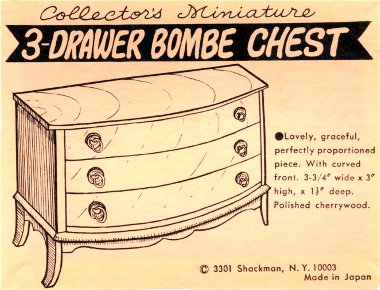 ir
speciality) and characterizatio
ir
speciality) and characterizatio ns into
"antique" and "vintage" (a fancy way of saying "used" or
"second hand") are useless. The collector must be leery of buying 1950s to 1970s
reproductions of high-style furnishings on the basis of them being described as made in
the early 20th century. The later pieces were made honestly at the time by firms such as
Sonia Messer, Shackman (right, c1970s, made in Japan, based on the
Hepplewhite style of the late 18th century) and Concord Museum (left,
c1970s, made in Taiwan, based on the Chippendale style of the mid 18th century)
to suit little girls' taste for "colonial" furniture. Such pieces are
collectible in their own right but may be worth less money than earlier pieces and should
be acknowledged for what they are. As most were not marked by the manufacturer,
identification can be a problem. Furthermore, as most miniatures are glued together
(rather than nailed), the style of nail (often a clue in dating full scale furniture) is
not available to help in the dating process. Wear is not necessarily a reliable clue (some
old pieces seem to have been owned by very careful children!).
ns into
"antique" and "vintage" (a fancy way of saying "used" or
"second hand") are useless. The collector must be leery of buying 1950s to 1970s
reproductions of high-style furnishings on the basis of them being described as made in
the early 20th century. The later pieces were made honestly at the time by firms such as
Sonia Messer, Shackman (right, c1970s, made in Japan, based on the
Hepplewhite style of the late 18th century) and Concord Museum (left,
c1970s, made in Taiwan, based on the Chippendale style of the mid 18th century)
to suit little girls' taste for "colonial" furniture. Such pieces are
collectible in their own right but may be worth less money than earlier pieces and should
be acknowledged for what they are. As most were not marked by the manufacturer,
identification can be a problem. Furthermore, as most miniatures are glued together
(rather than nailed), the style of nail (often a clue in dating full scale furniture) is
not available to help in the dating process. Wear is not necessarily a reliable clue (some
old pieces seem to have been owned by very careful children!).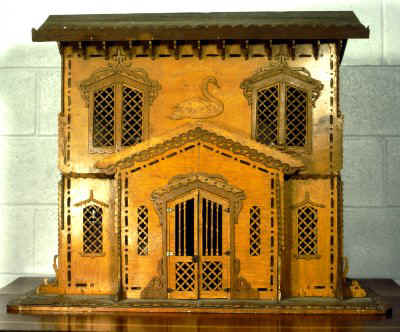
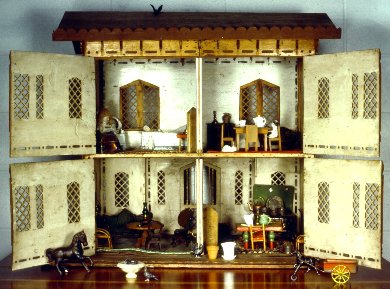
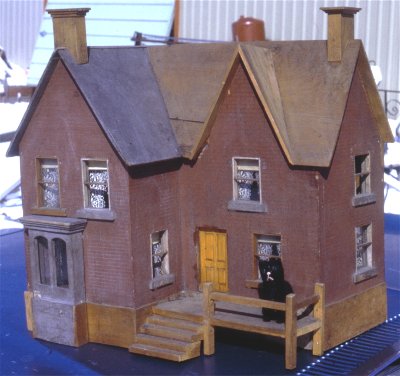
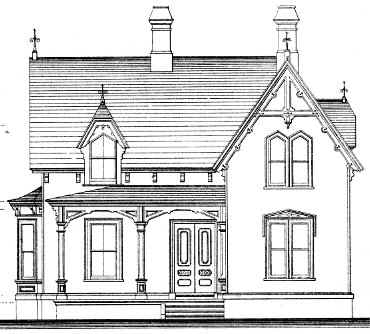 ingston,
Ontario, Canada, area may be based on an actual house. The L-shaped plan, steep pitched
roof interrupted by a tall dormer, high chimneys and bay window were found in architecture
of the late 19th and early 20th centuries.
ingston,
Ontario, Canada, area may be based on an actual house. The L-shaped plan, steep pitched
roof interrupted by a tall dormer, high chimneys and bay window were found in architecture
of the late 19th and early 20th centuries. 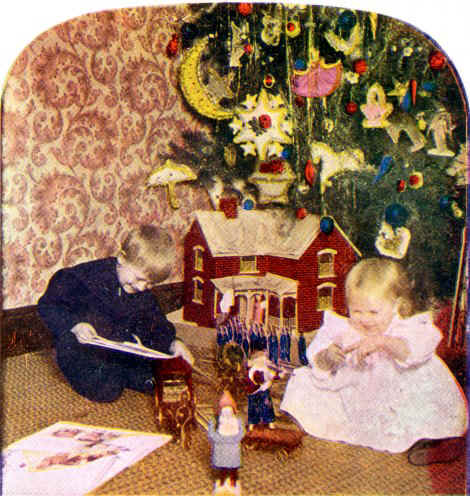
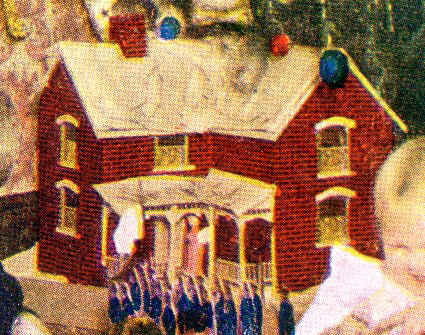
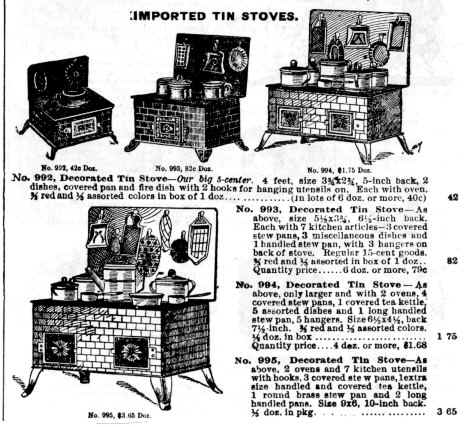 possibly fit in a large dollhouse.
possibly fit in a large dollhouse. 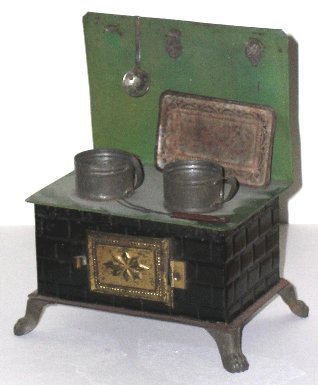

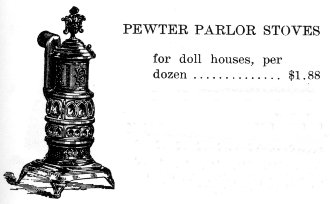
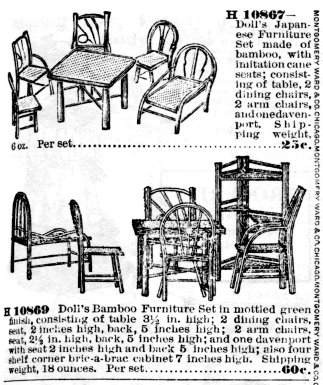
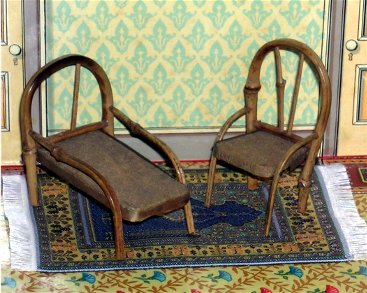
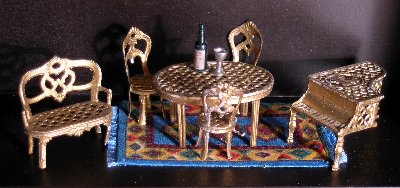
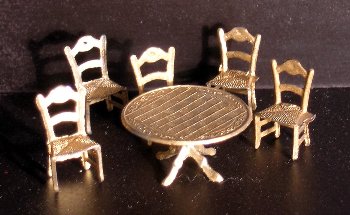
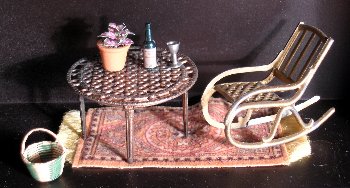
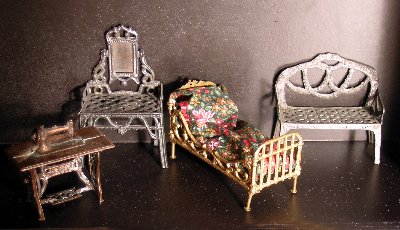
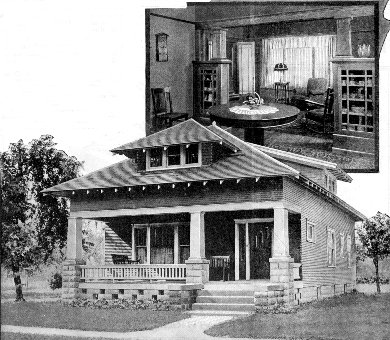
 or gable
roofs, and shingles used in a decorative manner. Exposed rafter ends are also featured in
this bungalow in Kingston, Ontario (right).
or gable
roofs, and shingles used in a decorative manner. Exposed rafter ends are also featured in
this bungalow in Kingston, Ontario (right).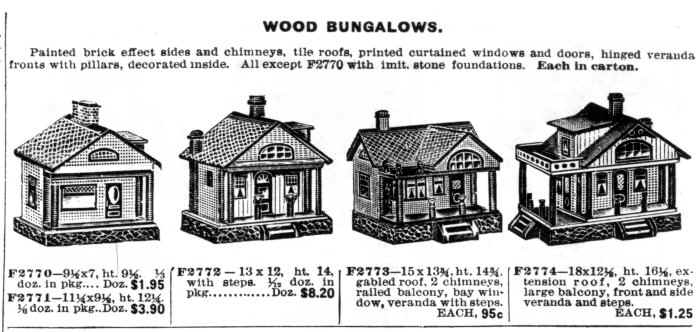
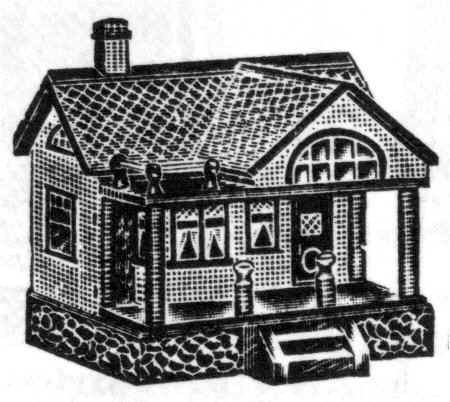
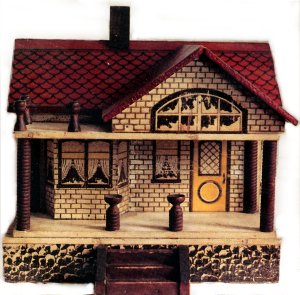
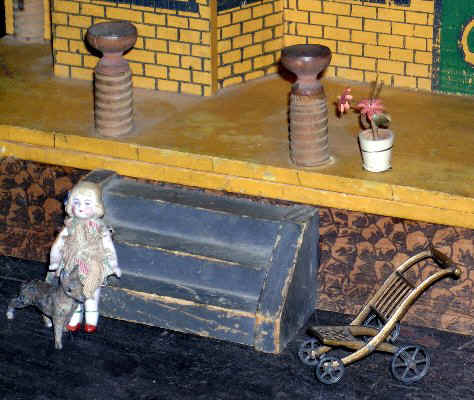

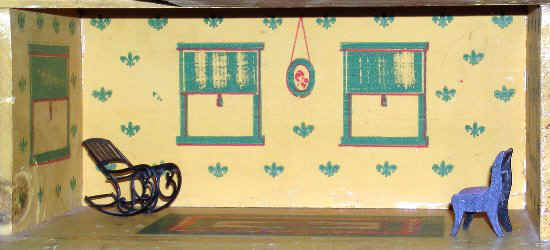
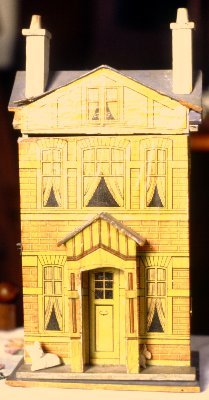
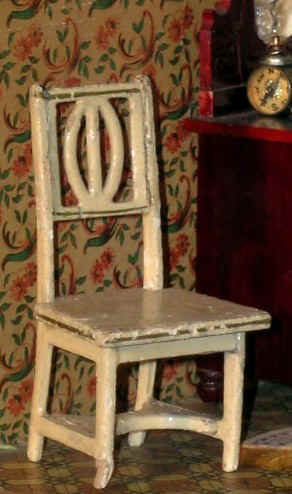 ;
cream paint with gold detailing applied over pressed cardboard; the curved stretcher and
oval motif in the back are derived from a lingering Art Nouveau style merging into Art
Deco.
;
cream paint with gold detailing applied over pressed cardboard; the curved stretcher and
oval motif in the back are derived from a lingering Art Nouveau style merging into Art
Deco.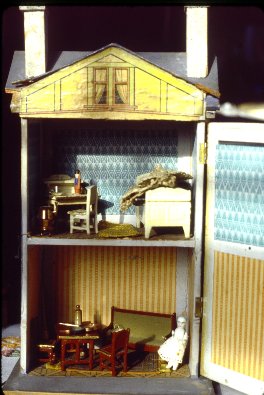 As the Gottschalk pieces are typically not
labelled, it is fortunate that some of their catalogues have been reproduced by Cieslik
and Ackerman (see
As the Gottschalk pieces are typically not
labelled, it is fortunate that some of their catalogues have been reproduced by Cieslik
and Ackerman (see 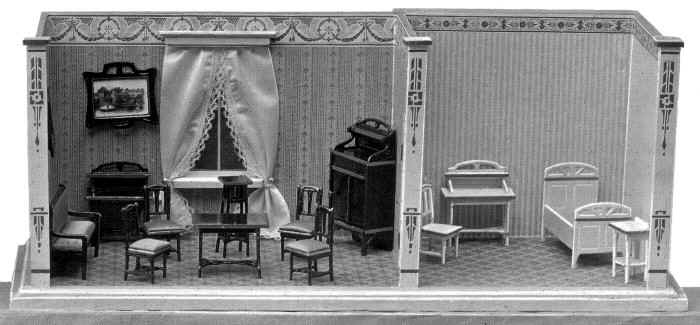
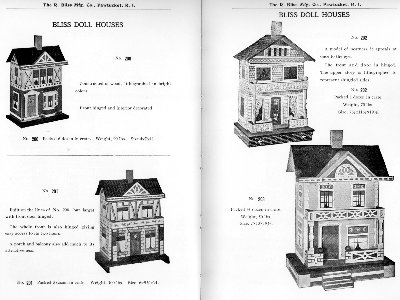
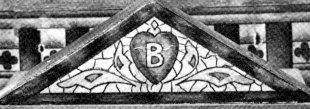
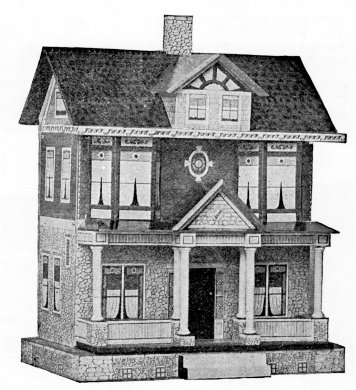
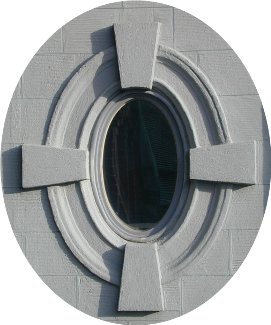
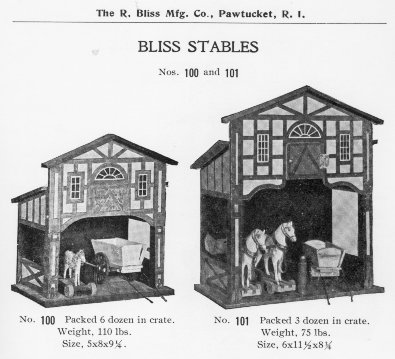
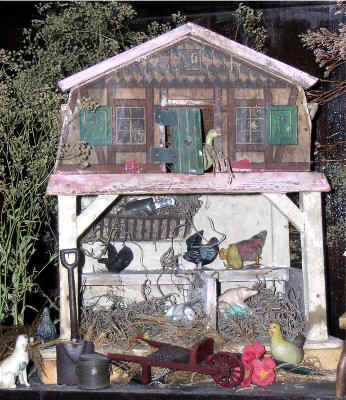
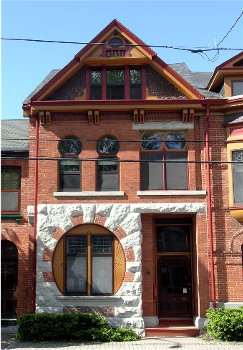
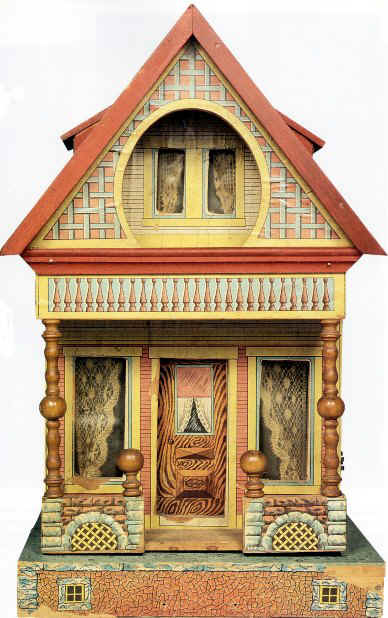
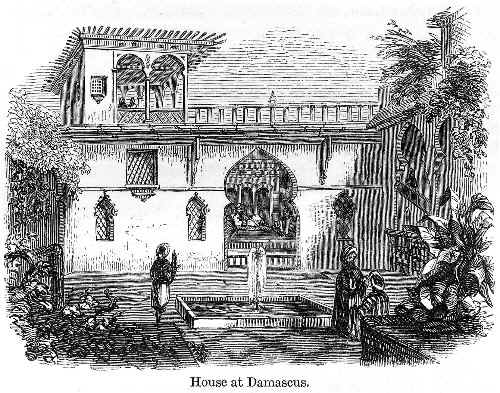
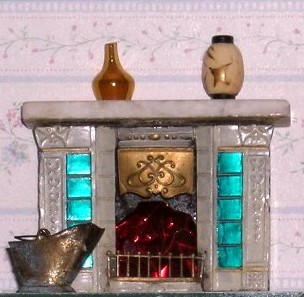
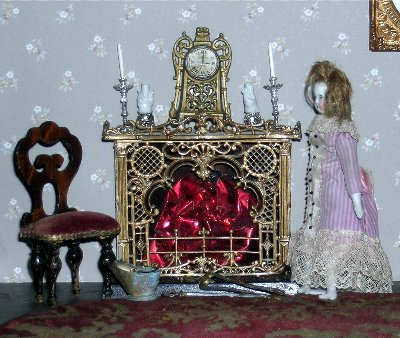
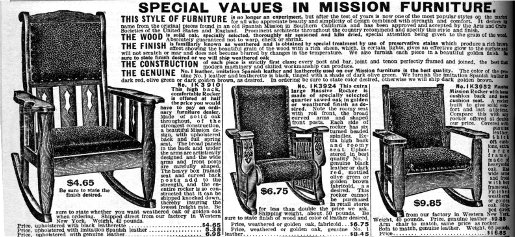
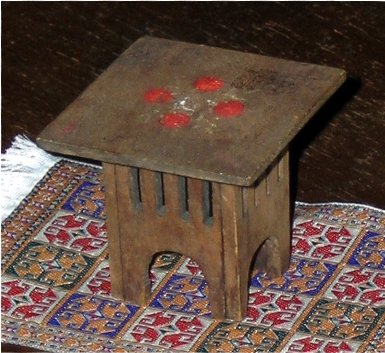
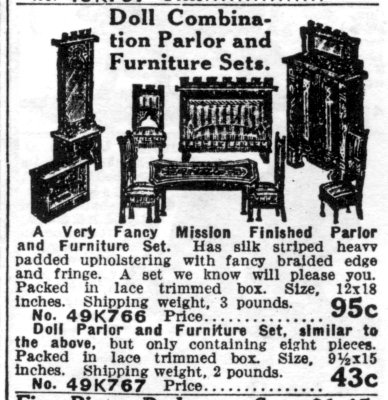
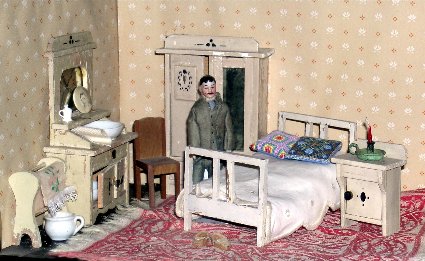 een even more clearly in
this dollhouse table-top, likely made in Germany, on the right)
painted details in black. The rectilinear lines of the furniture, relieved by simple
curves, are more characteristic of the second decad e of the
20th century than the fussy delicacy of the metal fireplaces illustrated above.
een even more clearly in
this dollhouse table-top, likely made in Germany, on the right)
painted details in black. The rectilinear lines of the furniture, relieved by simple
curves, are more characteristic of the second decad e of the
20th century than the fussy delicacy of the metal fireplaces illustrated above. 